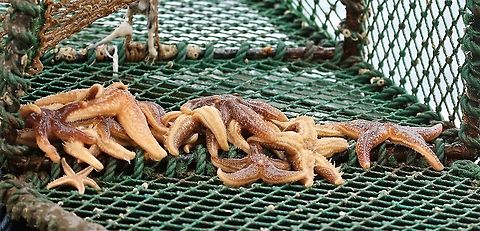
Appearance
The common starfish normally has five arms, broad at their base and gradually tapering to a point at their tips, which are often turned up slightly. There is a line of short white spines running along the centre of the aboral surface of the arms with low, soft mounds called papulae on either side.The oral surfaces of the arms have rows of small tube feet, used in locomotion and feeding. The starfish is usually orange or brick red on the aboral surface and paler on the oral surface but can also be purple or pale brown. Individuals from deep water are usually paler. It grows to a maximum diameter of about 52 centimetres but a more normal size is 10 to 30 cm.
Distribution
The common starfish is native to the northeastern Atlantic Ocean and its range extends from Norway and Sweden, through the North Sea, round the coasts of Britain, France, Spain and Portugal and southwards along the coasts of Africa to Senegal. It is largely absent from the Mediterranean Sea. It is also known from the western Atlantic where it occurs between Labrador and Florida and the Gulf of Mexico. It is capable of surviving in brackish water.Behavior
Common starfish are believed to live for about seven to eight years. When well fed, the juveniles can increase their radius at the rate of slightly more than 10 mm per month during the summer and autumn and slightly less than 5 millimetres per month in the winter. An adult common starfish can survive starvation for several months although it loses weight in the process. One specimen shrank from a radius of 6 centimetres to a radius of 3.8 centimetres after starvation for five months.Habitat
The common starfish feeds on a variety of benthic organisms. These include bivalve molluscs, polychaete worms, barnacles, gastropod molluscs, other echinoderms and carrion. When feeding on a mollusc such as a mussel, it attaches its tube feet to each shell valve and exerts force to separate them slightly. Even a gap of just 1 mm is sufficient for the starfish to insert a fold of its stomach, secrete enzymes and start digesting the mollusc body. When the contents are sufficiently liquid, it brings its stomach back to its rightful position with the food inside.The common starfish has a well-developed sense of smell and can detect the odour of prey species such as the common mussel and crawl towards it. It can also detect the odour of the predatory common sunstar, which eats other starfish, and take evasive action.
Reproduction
The common starfish is dioecious, which means that each individual is either male or female. In the spring, the females release their eggs into the sea. A moderate sized starfish is estimated to be able to produce 2.5 million eggs. The males shed their sperm and fertilisation takes place in the water column. The larvae are planktonic and drift for about 87 days before settling on the seabed and undergoing metamorphosis into juveniles.Defense
The common starfish produces a saponin-like substance designed to repel predators, which causes a reaction in the common whelk, a common prey species. At dilute concentrations it caused the whelk to take evasive action and at higher concentrations it produced a series of convulsions.References:
Some text fragments are auto parsed from Wikipedia.